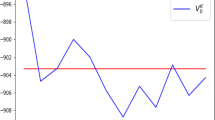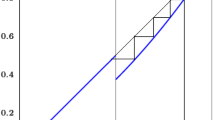Abstract
A perturbation method is proposed to calculate approximately the limit cycle type nonequilibrium steady-state resulting from periodic perturbation of coefficients of stable population systems; the two species Lotka-Volterra competition system is explicity studied and the results are formulated for general multi-species population systems. Avoidance of competitive or other types of exclusion of species in a periodic environment is indicated.
Similar content being viewed by others
Literature
Cushing, J. M. (1976). “Stable Limit Cycles of Time Dependent Multispecies Interactions.”Mathl. Biosci. 31, 259–273.
— (1977a). “Periodic Time-dependent Predator-Prey Systems.SIAM J. Appl. Math. 32, 82–95.
— (1977b). “Stable Positive Periodic Solutions of the Time dependent Logistic Equation Under Possible Hereditary Influences.”J. Math. Anal. Applics. 60, 747–754.
— (1977c). “Bifurcation of Periodic Solutions of Integrodifferential Systems with Application to Time Delay Models in Population Dynamics.”SIAM J. Appl. Math. 33, 640–654.
— (1979). “Nontrivial Periodic Solutions of Integrodifferential Equations.”J. Integral Equations 1, 165–181.
Cushing, J. M. (1980). “Two Species Competition in a Periodic Environment.”J. Math. Biol. (to appear).
Freedman, H. I. and P. Waltman. (1975). “Perturbations of Two-dimensional Predator-Prey Equations with an Unperturbed Critical Point.”SIAM J Appl. Math. 29, 719–733.
Grenny, W. J., D. A. Bella and H. C. Curl Jr. (1973). “A Theoretical Approach to Interspecific Competition in Phytoplankton Communities.”Am. Naturalist 107, 405–425.
Halanay, A. (1966).Differential Equations, Stability and Oscillations. New York: Academic Press.
Hutchinson, G. E. (1961). “The Paradox of Plankton.”Am. Naturalist 95, 137–145.
— (1967).A Treatise on Limnology, Vol. 2 New York: Wiley.
Koch, A. L. (1974). “Coexistence Resulting from an Alternation of Density Dependent and Density Independent Growth.”J. Theor. Biol. 44, 373–386.
Lin, J. and P. B. Khan. (1976). “Averaging methods in Predator-Prey Systems and Related Biological Models.”J. Theor. Biol. 57, 73–102.
MacArthur, R. and E. O. Wilson. (1967).The Theory of Island Biography. Princeton: Princeton University Press.
Nisbet, R. M. and W. S. C. Gurney. (1976). Population Dynamics in a Periodically Varying Environment.”J. Theor. Biol. 56, 459–475.
Stewart, F. M. and B. R. Levin. (1973). “Partitioning of Resources and the Outcome of Interspecific Competition: a Model and Some General Considerations.”Am. Naturalist 107, 171–198.
Tuljapurkar, S. D. and J. S. Semura. (1977). “Dynamic Equilibrium under Periodic Perturbations in Simple Ecosystem Models.”J. Theor. Biol. 66, 327–343.
Author information
Authors and Affiliations
Rights and permissions
About this article
Cite this article
Gopalsamy, K. Limit cycles in periodically perturbed population systems. Bltn Mathcal Biology 43, 463–485 (1981). https://doi.org/10.1007/BF02459434
Received:
Revised:
Issue Date:
DOI: https://doi.org/10.1007/BF02459434




